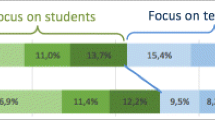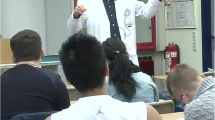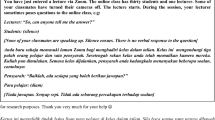Abstract
This study uses classroom videotapes to examine the phenomenon of students who are left behind during whole-class teaching. Zooming in via these videos enabled us to analyze these classroom situations by means of a compact, multi-perspective set of theories – van Hiele theory, conceptualization, and visual perception. The analysis provided a picture of the classroom interaction in which the sound of silence of those students who might not share understanding during the class discourse is ignored. Based on a sample of Taiwanese junior high school geometry classes, the study demonstrated how investigating situations of silence uncovered the possibility of teachers’ unawareness of student difficulties or their unsuccessful efforts to cope with them. Teachers’ post-lesson interviews and questionnaires shed additional light on the perspective of left-behind students. Implications of this method for pre- and in-service teachers’ programs are briefly discussed, and some recommendations for change are proposed.
Similar content being viewed by others
References
Aitken, J. & Mildon, D. (1991). The dynamics of personal knowledge and teacher education. Curriculum Inquiry, 211, 141–162.
Anderson, J. R. (1995). Cognitive psychology and its implications (4th ed). New York: Freeman.
Boaler, J. (2006). How a detracted mathematics approach promoted respect, responsibility, and high achievement. Theory into Practice, 45(1), 40–46.
Cai, J., Lin, F. & Fan, L. (2004). How do Chinese learn mathematics? Some evidence-based insights and needed directions. In L. Fan, N. Y. Wong, J. Cai & S. Li (Eds.), How Chinese Learn Mathematics: Perspectives from Insiders (pp. 535–554. )River Edge, NJ: World Scientific.
Chang, S. C. & Tsuei, M. P. (2006). A study of the dynamic cooperative learning and curriculum-based measurement model on third-grade students’ mathematics achievement. Journal of Elementary Education, 24, 59–88. (Chinese).
Chen, Y. T. & Yau, R. F. (2004). High school students learning performance in a cooperative-learning math class. Journal of Taitung University of Education, 15(1), 127–166. (Chinese).
Cohen, E. & Lotan, R. (Eds.). (1997). Working for equity in heterogeneous classrooms: Sociological theory in practice. New York: Teachers College Press.
Davis, B. & Simmt, E. (2003). Understanding learning systems: Mathematics education and complexity science. Journal for Research in Mathematics Education, 34(2), 137–167.
Fan, L., Wong, N. Y., Cai, J. & Li, S. (2004). How Chinese learn mathematics: Perspectives from insiders. River Edge, NJ: World Scientific.
Fischbein, E. & Nachlieli, T. (1998). Concepts and figures in geometrical reasoning. International Journal of Science Education, 20(10), 1193–1211.
Gal, H. (2005). Identifying Problematic Learning Situations in Geometry Instruction, and Handling Them within the Framework of Teacher Training. Dissertation, Hebrew University of Jerusalem. (Hebrew)
Gal, H., Lin, F. L. & Ying, J. M. (2006). The hidden side in Taiwanese classrooms – Through the lens of PLS in geometry. In J. Novotna, H. Moraova, M. Kratka & N. Stehlikova (Eds.), Proceedings of the 30th international conference for the psychology of mathematics education, 3 (pp. 145–152). Prague, The Czech Republic.
Gal, H. & Linchevski, L. (2000). When a learning situation becomes a problematic learning situation: The case of diagonals in the quadrangle. In T. Nakahara & M. Koyama (Eds.), Proceedings of the 24th international conference for the psychology of mathematics education (pp. 297–304). Hiroshima, Japan.
Gal, H. & Linchevski, L. (2002). Analyzing geometry Problematic Learning Situations by theory of perception. In A. Cockburn & E. Nardi (Eds.), Proceedings of the 26th international conference for the psychology of mathematics education (pp. 400–407). Norwich, United Kingdom.
Hershkowitz, R. (1989). Visualization in geometry: Two sides of the coin. Focus on Learning Problems in Mathematics, 11(1), 61–76.
Hiebert, J., Morris, A., Berk, D. & Jansen, A. (2007). Preparing teachers to learn from teaching. Journal of Teacher Education, 58(1), 47–61.
Hoffer, A. (1983). Van Hiele-based research. In R. Lesh & M. Landau (Eds.), Acquisition of mathematics concepts and processes (pp. 205–227. )New York: Academic Press.
Jansen, A. (2006). Seventh graders’ motivations for participating in two discussion-oriented mathematics classrooms. The Elementary School Journal, 106(5), 409–427.
Jansen, A. (2008). An investigation of relationships between seventh-grade students’ beliefs and their participation during mathematics discussions in two classrooms. Mathematical Thinking and Learning, 10(1), 68–100.
Jaworski, A. (1993). The power of silence: Social and pragmatic perspectives. Newbury Park, CA: Sage.
Kieran, C. (2001). The mathematical discourse of 13-year-old partnered problem solving and its relation to the mathematics that emerges. Educational Studies in Mathematics, 46, 187–228.
Leinhardt, G. & Steeles, M. (2005). Seeing the complexity of standing to the side: Instructional dialogues. Cognition and Instruction, 23(1), 87–163.
Lin, P. J. (2005). Using research-based video cases to help pre-service primary teachers conceptualize a contemporary view of mathematics teaching. International Journal of Science and Mathematics Education, 3, 351–377.
Ministry of Education, Taiwan (2006). Minutes of the first coordination meeting between the ministry of education and national science council. Taipei: Ministry of Education, Taiwan.
Mullis, I., Martin, M., Gonzalez, E. & Chrostowski, S. (2004). TIMSS 2003 international mathematics report: Findings from IEA’s trends in international mathematics and science study at the 4 th th grades. Chestnut Hill, MA: Boston College.
Reed, S. (1974). Structural descriptions and the limitations of visual images. Memory and Cognition, 2, 329–336.
Santagata, R. & Barbieri, A. (2005). Mathematics teaching in Italy: A cross-cultural video analysis. Mathematical Thinking, 7(4), 291–312.
Sherin, M. & van Es, E. (2005). Using video to support teachers’ ability to notice classroom interactions. Journal of Technology and Teacher Education, 13(3), 475–491.
Stigler, J. W., Gallimore, R. & Hiebert, J. (2000). Using video surveys to compare classrooms and teaching across cultures: Examples and lessons from the TIMSS video studies. Educational Psychologist, 35(2), 87–100.
Vinner, S. (1997). The pseudo-conceptual and pseudo-analytical thought processes in mathematics learning. Educational Studies in Mathematics, 34, 97–129.
Wang, C. K. & Chang, S. J. (2003). A teacher’s implementation of cooperative learning in a sixth-grade classroom: A case study in language arts. Educational Review, 21, 53–78. (Chinese).
Author information
Authors and Affiliations
Corresponding author
Electronic supplementary material
Below are the links to the electronic supplementary material.
ESM Table 1
Teachers’ background (DOC 31.0 KB)
ESM Table 2
Methods to detect Situations of Silence (SoS) and teachers’ perspectives (DOC 31.5 KB)
ESM Table 3
Relation of an angle at the circumference and the arc it contains (DOC 24.0 KB)
ESM Table 4
Relations between two circles (Episode 3a) (DOC 37.0 KB)
ESM 5
One of the most widely used and accepted methods in Taiwan’s elementary schools is the cooperative learning approach of the Student Teams Achievement Division (STAD), whose teaching process in Taiwan often includes a whole-class introduction, group practice, a quiz and group processing (e.g., Chang & Tsuei, 2006; Wang & Chang, 2003). There have also been some attempts to introduce cooperative approaches into high schools, with positive results (e.g., Chen & Yau, 2004). (DOC 19.5 KB)
ESM 6
International comparisons indicate that mathematics performance is remarkable in some countries, e.g., Singapore, Japan, Korea and Taiwan, as measured by TIMSS (Mullis, Martin, Gonzales, & Chrostowski 2004). However, a closer look reveals mixed results, suggesting that some students have been left behind. Though Taiwanese eighth graders achieved a high average score in TIMSS, 15% of them were situated below intermediate or low benchmarks. While this was much lower than the international average of 51%, Taiwan’s percentage was still higher than those of other “best achieving” countries (Singapore, South Korea, and Hong Kong). Moreover, the distribution of math achievements among all Taiwanese eighth graders is one of the widest (Mullis, Martin, Gonzales, & Chrostowski 2004). The initiative to address the problem and to improve achievements of the lower part of the scale invited enquiry of the left-behind phenomenon. (DOC 20.0 KB)
Rights and permissions
About this article
Cite this article
Gal, H., Lin, FL. & Ying, JM. LISTEN TO THE SILENCE: THE LEFT-BEHIND PHENOMENON AS SEEN THROUGH CLASSROOM VIDEOS AND TEACHERS’ REFLECTIONS. Int J of Sci and Math Educ 7, 405–429 (2009). https://doi.org/10.1007/s10763-008-9139-6
Received:
Accepted:
Published:
Issue Date:
DOI: https://doi.org/10.1007/s10763-008-9139-6




